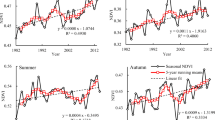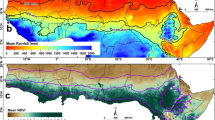Abstract
Extensive studies have investigated the relationships between climate change and vegetation dynamics. However, the geographic controls on vegetation dynamics are rarely studied. In this study, the geographic controls on the trends and variation of vegetation greenness in middle and eastern Inner Mongolia, China (mid-eastern Inner Mongolia) were investigated. The SPOT VEGETATION 10-day period synthesis archive of normalized difference vegetation index (NDVI) from 1999 to 2007 was used for this study. First, the maximum value compositing (MVC) method was applied to derive monthly maximum NDVI (MNDVI), and then yearly mean NDVI (YMNDVI) was calculated by averaging the MNDVIs. The greenness rate of change (GRC) and the coefficient of variation (CV) were used to monitor the trends and variation in YMNDVI at each raster grid for different vegetation types, which were determined from a land use dataset at a scale of 1:100,000, interpreted from Landsat TM images in 2000. The possible effects of geographic factors including elevation, slope and aspect on GRC and CV for three main vegetation types (cropland, forest and steppe) were analyzed. The results indicate that the average NDVI values during the 9-year study period for steppe, forest and cropland were 0.26, 0.41 and 0.32, respectively; while the GRC was 0.008, 0.042 and 0.033 per decade, respectively; and CVs were 10.2, 4.8 and 7.1%, respectively. Cropland and steppe shared a similar trend in NDVI variation, with both decreasing initially and then increasing over the study period. The forest YMNDVI increased throughout the study period. The GRCs of the forest also increased, although GRCs for cropland and steppe decreased with increasing elevation. The GRCs of cropland and steppe increased with increasing slope, but the forest GRCs were not as closely related to slope. All three vegetation types exhibited the same effects in that the GRC was larger on north-facing (shady) slopes than south-facing slopes due to differences in water conditions. The CVs of the three vegetation types showed different features to the GRC. The CVs for all three vegetation types were not affected by aspect. The CVs for forest and cropland showed minor effects with changes in elevation and slope, but the CV for steppe decreased with increasing slope, and increased with increasing elevations to 1,200 m, before decreasing at higher elevations. Our findings suggest that the role of geographic factors in controlling GRC should also be considered alongside climate factors.









Similar content being viewed by others
References
Bagan H, Wang Q, Yang Y, Yasuoka Y, Bao Y (2007) Land cover classification using moderate resolution imaging spectrometer-enhanced vegetation index time-series data and self-organizing map neural network in Inner Mongolia, China. J Appl Remote Sens 1:013545
Carlson TN, Ripley DA (1997) On the relation between NDVI, fractional vegetation cover, and leaf area index. Remote Sens Environ 62:241–252
Chen X, Wang H (2009) Spatial and temporal variations of vegetation belts and vegetation cover degrees in Inner Mongolia from 1982 to 2003. Acta Geogr Sin 64:84–94
Chen X, Zheng T (2008) Spatial patterns of aboveground biomass and its climatic attributions in typical steppe of Inner Mongolia. Sci Geogr Sin 28:369–374
Chen ZM, Babiker IS, Chen ZX, Komaki K, Mohamed MAA, Kato K (2004) Estimation of interannual variation in productivity of global vegetation using NDVI data. Int J Remote Sens 25:3139–3159
Di LP, Rundquist DC, Han LH (1994) Modeling relationships between NDVI and precipitation during vegetative growth cycles. Int J Remote Sens 15:2121–2136
Ding Y, Ren G, Shi G, Gong P, Zheng X, Zhai P, Zhang DE, Zhao Z, Wang S, Wang H, Luo Y, Chen D, Gao X, Dai X (2006) National assessment report of climate change (I): climate change in China and its future trend. Adv Clim Chang Res 2:3–8
Ding MJ, Zhang YL, Liu LS, Zhang W, Wang ZF, Bai WQ (2007) The relationship between NDVI and precipitation on the Tibetan Plateau. J Geogr Sci 17:259–268
Du L, Li G (2008) Dynamic monitoring of eco-environment change over 1999–2006 in Yanchi County, Ningxia Hui Autonomous Region based on SPOT-VGT data. J Beijing For Univ 30:46–51
Geerken R, Zaitchik B, Evans JP (2005) Classifying rangeland vegetation type and coverage from NDVI time series using Fourier filtered cycle similarity. Int J Remote Sens 26:5535–5554
He S, Liu H, Ren J, Yin Y (2008) Landform-climate-vegetation patterns and countermeasures for vegetation rehabilitation of forest-steppe ecotone on southeastern Inner Mongolia Plateau. Sci Geogr Sin 28:253–258
Holben BN (1986) Characteristics of maximum-value composite images from temporal AVHRR data. Int J Remote Sens 7:1417–1434
Hou Q, Yang Z, Yang L, Li X (2008) Climatic characteristics for grain production area in the east of Inner Mongolia from 1953 to 2005. J Meteorol Environ 24:6–12
Lasponara R (2006) On the use of principal component analysis (PCA) for evaluating interannual vegetation anomalies from SPOT/VEGETATION NDVI temporal series. Ecol Model 194:429–434
Li X, Shi P (1999) Research on regulation of NDVI change of Chinese primary vegetation types based on NOAA/AVHRR data. Acta Bot Sin 41:314–324
Li X, Shi P (2000) Sensitivity analysis of variation in NDVI, temperature and precipitation in typical vegetation types across China. Acta Phytoecol Sin 24:379–382
Liu JY, Liu ML, Zhuang DF, Zhang ZX, Deng XZ (2003) Study on spatial pattern of land-use change in China during 1995–2000. Sci China Ser D Earth Sci 46:373–384
Liu JY, Liu ML, Tian HQ, Zhuang DF, Zhang ZX, Zhang W, Tang XM, Deng XZ (2005a) Spatial and temporal patterns of China’s cropland during 1990–2000: an analysis based on Landsat TM data. Remote Sens Environ 98:442–456
Liu JY, Tian HQ, Liu ML, Zhuang DF, Melillo JM, Zhang ZX (2005b) China’s changing landscape during the 1990s: large-scale land transformations estimated with satellite data. Geophys Res Lett 32:5
Ma MG, Yi S, Xuemei W (2007) Precipitation and temperature control the greening trend in the northwest China during 1982–2003. In: Neale CMU, Owe M, Durso G (eds) Conference on remote sensing for agriculture, ecosystems, and hydrology IX, Florence, Italy 67420X:X7420
Matsushita B, Yang W, Chen J, Onda Y, Qiu GY (2007) Sensitivity of the enhanced vegetation index (EVI) and normalized difference vegetation index (NDVI) to topographic effects: a case study in high-density cypress forest. Sensors-Basel 7:2636–2651
Myneni RB, Keeling CD, Tucker CJ, Asrar G, Nemani RR (1997) Increased plant growth in the northern high latitudes from 1981 to 1991. Nature 386:698–702
Olthof I, Pouliot D, Latifovic R, Chen WJ (2008) Recent (1986–2006) vegetation-specific NDVI trends in Northern Canada from satellite data. Arctic 61:381–394
Pei SF, Fu H, Wan CG (2008) Changes in soil properties and vegetation following exclosure and grazing in degraded Alxa desert steppe of Inner Mongolia, China. Agric Ecosyst Environ 124:33–39
Pickup G, Chewings VH (1996) Correlations between DEM-derived topographic indices and remotely sensed vegetation cover in rangelands. Earth Surf Proc Land 21:517–529
Propastin PA, Kappas M (2008) Reducing uncertainty in modeling the NDVI-precipitation relationship: a comparative study using global and local regression techniques. Geosci Remote Sens 45:47–67
Qin D, Ding Y, Su J, Ren J, Wang S, Wu R, Yang X, Wang S, Liu S, Dong G, Lu Q, Huang Z, Du B, Luo Y (2005) Assessment of climate and environment changes in China (I): climate and environment changes in China and their projection. Adv Clim Chang Res 1:4–9
Reuter HI, Nelson A, Jarvis A (2007) An evaluation of void-filling interpolation methods for SRTM data. Int J of Geogr Inf Sci 21:983–1008
Runnstrom MC (2000) Is northern China winning the battle against desertification? Satellite remote sensing as a tool to study biomass trends on the Ordos Plateau in semiarid China. Ambio 29:468–476
Schultz PA, Halpert MS (1993) Global correlation of temperature, NDVI and precipitation. Adv Space Res 13:277–280
Sheng Y, Chen W, Xiao Q, Guo L (1995) Macro classification of vegetation in China with NOAA/NDVIs. Chin Sci Bull 40:68–71
Song BM, Huang DM, Wang RQ, Masae S, Xu F, Wang W, Zhang GS, Zhang XQ, Qiao J (2008) A measure for spatial heterogeneity of vegetation in the Center of Inner Mongolia. Prog Nat Sci 18:289–295
Stow D, Daeschner S, Hope A, Douglas D, Petersen A, Myneni R, Zhou L, Oechel W (2003) Variability of the seasonally integrated normalized difference vegetation index across the north slope of Alaska in the 1990s. Int J Remote Sens 24:1111–1117
Stow D, Petersen A, Hope A, Engstrom R, Coulter L (2007) Greenness trends of Arctic tundra vegetation in the 1990s: comparison of two NDVI data sets from NOAA AVHRR systems. Int J Remote Sens 28:4807–4822
Tao F, Yokozawa M, Hayashi Y, Lin E (2005a) A perspective on water resources in China: interactions between climate change and soil degradation. Clim Chang 68:169–197
Tao FL, Yokozawa M, Zhang Z, Xu YL, Hayashi Y (2005b) Remote sensing of crop production in China by production efficiency models: models comparisons, estimates and uncertainties. Ecol Model 183:385–396
Tao F, Yokozawa M, Zhang Z, Hayashi Y, Ishigooka Y (2008) Land surface phenology dynamics and climate variations in the North East China Transect (NECT), 1982–2000. Int J Remote Sens 29:5461–5478
Wang J, Rich PM, Price KP (2003) Temporal responses of NDVI to precipitation and temperature in the central Great Plains, USA. Int J Remote Sens 24:2345–2364
Wessels KJ, Prince SD, Zambatis N, Macfadyen S, Frost PE, Van ZD (2006) Relationship between herbaceous biomass and 1-km(2) advanced very high resolution radiometer (AVHRR) NDVI in Kruger National Park, South Africa. Int J Remote Sens 27:951–973
Yamano H, Chen J, Tamura M (2003) Hyperspectral identification of grassland vegetation in Xilinhot, Inner Mongolia, China. Int J Remote Sens 24:3171–3178
Yiu L, Cheng Y, Guo R, Li J, Ding X (2008) Climate warming and its impacts in Chifeng. Chin J Agrometeorol 29:134–138
Zhang J, Ge J, Guo Q (2001) The relation between the change of NDVI of the main vegetational types and the climatic factors in the northeast of China. Acta Ecol Sin 21:522–527
Zhang F, Wu BF, Li CL (2003) Using time series of SPOT VGT NDVI for crop yield forecasting. In: Proceedings IGARSS 2003: IEEE international geoscience and remote sensing symposium, vols I–VII, pp 386–388
Zhou ZY, Sun OJ, Huang JH, Li LH, Liu P, Han XG (2007) Soil carbon and nitrogen stores and storage potential as affected by land-use in an agro-pastoral ecotone of northern China. Biogeochemistry 82:127–138
Zou YR, Zhang ZX (2005) Analysis on the anthropogenic driving forces of land use Chang in typical agro-pastoral ecotone of China. Environ Inform Arch 3:387–390
Acknowledgments
This study was supported by the Knowledge Innovation Program of the Chinese Academy of Sciences (No. KSCX1-YW-09-01), the Open Project Program of Key Laboratory of Resources Remote Sensing and Digital Agriculture, Ministry of Agriculture (No. RDA0903), and the National Key Programme for Developing Basic Science (No. 2009CB421105). F. Tao acknowledges the support of the ‘Hundred Talents’ Program of the Chinese Academy of Sciences. We thank anonymous reviewers who provided very valuable comments and Dr. Shanzhong Qi for his suggestions.
Author information
Authors and Affiliations
Corresponding author
Rights and permissions
About this article
Cite this article
Dong, J., Tao, F. & Zhang, G. Trends and variation in vegetation greenness related to geographic controls in middle and eastern Inner Mongolia, China. Environ Earth Sci 62, 245–256 (2011). https://doi.org/10.1007/s12665-010-0518-2
Received:
Accepted:
Published:
Issue Date:
DOI: https://doi.org/10.1007/s12665-010-0518-2




